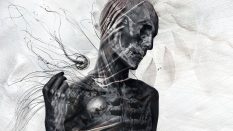
Editor's Choice April 2017

…
This month’s’ Editor’s Choice comes late yet again and this time I have no excuse besides watching too many .gifs of Marine Le Pen balling her eyes out.
I kid. I kid. It was just one .gif.
In seriousness, I found beginning this post to be a bit difficult because I don’t want to talk about metal initially. Instead, I want to talk about food.
I have a tremendous soft spot for television shows about exotic cooking. I’ve been a loyal adherent of Anthony Bourdain’s for some time. Bourdin is a rock fan, but not an extreme metal fan, which makes him relatable to me. Better, Bourdain uses the examination of food as a pretense for examining the environments and societies that produce the food that he eats. Bourdain’s various shows posit a world that is made up of a single indivisible cultural fabric. In many ways, I see the examination of music the same way.
Here’s an example: Deathspell Omega and Gojira share few outright similarities beyond that both acts are French, and that both caught the ears of the global metal music at a similar point in time. Si Monumentum Requires Circumspice was released in 2004, and From Mars to Sirius was released, in France at least, in 2005. That’s relatively proximate, considering that I cannot think of a French band so acclaimed releasing a record before that time. Both acts also re-imagined relatively obvious and trite sounds (second wave black metal, 90’s metallic rock) and ideas (satanism, new wave mysticism) with new aesthetic and timbral ideas, and presented them in a way which rejuvenated both styles. It seems there was something in the water in France at that time, though without a metallic Bourdain reporting from street level around the time it’s impossible to speculate what exactly. Much music criticism does not endeavor to look at these kinds of connections.
Food and music share enough similarities to warrant looking at the two art forms the same way. For one, each is prehistoric and tool-reliant. We first used urns to cook fish soup 15 thousand years ago. The first musical instruments were played more than 40 thousand years ago. Only painting dates back to this time frame. Poetry and storytelling draw from the infinite back of possibilities that vocabulary and language offer, and visual art is only limited by the artist’s skill, but cooking and music rely on technology and the instruments or ingredients available on hand. Music and cooking do not use language or images to communicate, at least for the most part. Even in the average pop song, the human voice takes up a quarter or less of the instrumentation, and much of the information conveyed by the voice is tonal or melodic, not linguistic. In extreme metal especially, the lyrics can have more intellectual value than they do impact on the overall experience.
Music and food also share a morbid past muddled by our modern zeitgeist. The aforementioned early instruments were made from hollowed out bones. In those times no human being would go very long without killing an animal or plant in order to eat it. In modern times, the reality of agribusiness has separated many people from the experience of killing their own food. Likewise, the invention of the record player means people don’t need to know how to play music, or seek out a skilled musician in order to hear songs, even though personal experience leads me to believe that many metal enthusiasts know how to play instruments.
What can reading food criticism, or watching people like Bourdain, teach us about appreciating music? Maybe to always consider its past and the context in which it was created, but also to see music as something both worth savoring and as something essential to life in the way food is. American cuisine especially, acts like food has an infinite supply but is mostly bland. YouTube posits that music is mostly the same, plentiful but lacking individual impact. People are beginning to understand that preserving the culture of cuisine, and sourcing what we eat, has value. Maybe it’s time to do the same with music. Treat these morsels as delicacies, not entertainment. Eat every meal like it could be your least. Hear every record like it could play at your funeral.
…
We’ve covered Ottawa, Ontario’s The Sun Through a Telescope before, and while this year’s Black Hole Smile doesn’t upend any of the patterns set on 2013’s I Die Smiling, it’s still a disruptive record. Sole musician Lee Neutron blends recognizable styles into a sophisticated, tough-to-pin-down whole. Oftentimes he plays with filthy noise and plodding rhythms. Other times, and very rarely, a melody will remind me of Husker Du. These kinds of extreme stylistic blends have made notable names out of European groups like Kvelertak, Tribulation and Oranssi Pazuzu, and Neutron has the same breadth as those artists albeit with wholly different aesthetics and ingredients.
…
My gut says Scotland’s Bitter Lake will divide listeners. Amateurish in the extreme, Distortions in Sombre presets itself as an audodidact’s bedroom black metal project with no aesthetic cohesion. In practice, though, the “atmosphere” and “black metal” parts take a back seat to massive distorted drums reminiscent of early Ministry as recreated via Fruity Loops. Blown out doesn’t begin to describe its percussive headache. Few “raw” black metal demos across my desk dare to be this aggressive.
…
I’ve seen more people give the new Mastodon album, The Emperor of Sand, a pass than its predecessor, Once More Round the Sun. That’s what happens when a band wisely decides to let the cheerleaders sit on the bench for this game and hopefully forever. For my money, both records pack a few hits and a whole lotta misses. Arcadea packs more punch. The upcoming project featuring drummer Brann Dailor, Core Atoms of Gaylord, and Raheem Amlani of Withered and the always-underappreciated Scarab, doubles down on the pop and progressive elements that Mastodon began to really play with on Crack the Skye. It wont console anyone who wants a return to Remission but at least offers an inherent critique of post-prog Mastodon: if you cannot return to where you started from, then get as far away as you can.
…
In contrast, Necrot remember exactly what made them great on their upcoming and long-gestating debut, Blood Offerings. Sharing members with Acephalix,Vastum and Rude, the Bay Area death metal power trios lots neatly into that region’s fertile death metal sound, primitive but always hooky. Their collected demos portray a band lovingly recreating first generation death metal both American and European, the kind that still had audible traces of NWOBHM and thrash in it. The opening riff to “Empty Hands”, the first song released from Blood Offerings, displays that same melodic sense, especially when it returns with octave harmony.
…
Further evidence of the Bay Area’s fertility, Ails features Christy Cather and Laurie Sue Shanaman, formerly of Ludicra. If that name doesn’t mean anything to you, dear reader, please refer to our extensive coverage of the band’s history. In their time Ludicra blended old school heavy metal, crust, prog and black metal into an indelible blend of sounds. They might have been the best black metal band in the US, period. That history and burden unfairly weighs on Ails, but just one demo into their discography Cather and Shanaman, with some help from guitarist Sam Abend (Desolation, Abrubt, Scurvy Dogs), drummer Colby Byrn (One In The Chamber, 2084, Aequorea) and bassist Jason Miller (Apocryphon, Cretaceous, Phantom Limbs), seem up to wearing that crown. “Dead Metaphors” maintains two central parts of the Ludicra sound. First, a delicate guitar flourish sensibility. Second, a knack for holding the listener’s interest for nearly ten minutes. The queen is dead, long live the queen.
…
Chicago’s Satan’s Hollow do nothing new, but the indicate a rising interest in classic, pre-extreme metal sounds. It’s tough to wear that crown and come from the same city as High Spirits, but the band’s self-titled debut is more than ready to box the regional champ. The ghost of Dio haunts the band, thanks in no small part to Mandy Martillo’s powerful voice and intricate lyrics.
…
100 Years say on their Facebook that the band should appeal to fans of Celtic Frost, Voivod and Swans. Those comparisons imply a kind of progressive ambition. It’s present, but their debut record isn’t some kind of art piece. Instead, it’s a pretty ideal balance of post-metal meditation and crusty drive. In an alternate timeline Neurosis stumbled onto this formula if they listened more to their punk leanings and less to their atavistic sensibilities. I’m not sure I’ve heard another record quite like 100 Years.
…
Last, a blast from the past courtesy of longtime reader Christian Dalton. The Black League has almost no music on most streaming channels. Spotify only carries their 2009 swansong, Ghost Brothel. Their debut, Ichor is better, but not because it sounds raw and sloppy. Founding singer Tanlei Jarva was a veteran performer from his time in Sentenced (not to mention a former bassist in Impaled Nazarene) when Ichor was written. His backing band were pretty much nobodies, but they played like headliners. Rotting Christ’s anthemic lurch met the Gothenburg sound before it became too quantized on this album. Some hints of 80’s Judas Priest show themselves as well. Dalton framed the band as a precursor to Tribulation and he’s right. I’m not surprised a few smart songwriters are trying to find this particular kind of black magic again.
…











